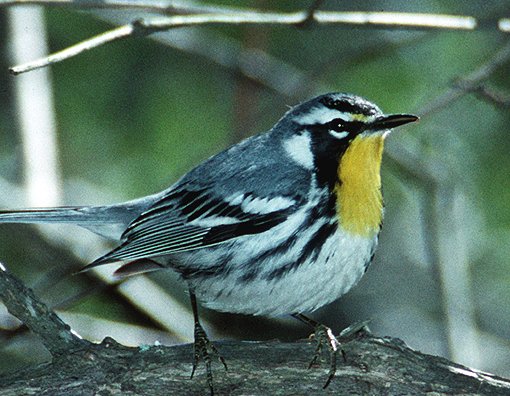|
Yellow-throated Warbler Dendroica dominica Reinita Gargantiamarilla, |
 |
|
Photo: G. Beaton
|
|
Yellow-throated Warbler Dendroica dominica Reinita Gargantiamarilla, |
 |
|
Photo: G. Beaton
|
|
IDENTIFICATION: A gray-backed warbler with a yellow throat, black streaks on white sides, and a distinctive black-and-white face pattern. Length: 13-16 cm.; weight: 10-11 g. VOICE: The call note is a loud, high-pitched "see." Audio (M. Oberle). HABITAT: Palms, mangroves, and coastal scrub in winter. HABITS: The Yellow-throated Warbler hops along large limbs and epiphytes in search of insects and spiders. It is less active than many other warblers, so may be hard to see high in the treetops. It uses its relatively long bill to probe crevices and leaf clusters for insects that are out of range for many other warbler species with shorter bills. It also gleans insects off leaves and occasionally catches them in mid-air. It breeds in the eastern forests of North America where it occupies two very different forest types: dry pine-oak forests, or swamps and river bottoms with tall trees, especially if Spanish moss is present (Tillandsia usneoides). The female builds a nest high in the forest canopy and lays four eggs in a clutch. The female does all the incubation for 12-13 days while the male sings nearby, guarding the territory. Both sexes feed the chicks. Yellow-throated Warblers that breed in the southeastern USA often stay there for the winter, whereas breeders in the northeastern part of the breeding range migrate to the southeastern USA and the Caribbean for the winter. STATUS AND CONSERVATION: An uncommon winter resident. Unlike many other warbler species, this species may have an increasing population as it expands its breeding range northward for unknown reasons. RANGE: Breeds from Illinois and Pennsylvania, south to Texas and Florida. It winters from coastal South Carolina to Nicaragua, and in the West Indies east to Guadeloupe. TAXONOMY: PASSERIFORMES; PARULIDAE. A distinctive, non-migratory race (Dendroica dominica flavescens) is a permanent resident on the northern Bahamas Islands of Little Abaco, Great Abaco and Grand Bahama, and may in fact represent a distinct species. |
|
 |
|
|
Photo: B. Hallett
|
 |
|
Photo: G. Beaton
|
|
References Arendt, W.J. 1992. Status of North American migrant landbirds in the Caribbean region: a summary. Pp. 143-171 in Ecology and conservation of neotropical migrant landbirds (J.M. Hagan III and D.W. Johnston, eds.) Smithsonian Instit. Press, Washington, D.C. Bent, A.C. 1953. Life histories of North American wood warblers. Smithsonian Instit. U.S. National Museum Bull. 203. (Reprinted by Dover Press, NY, 1963). Dunn, J. and K. Garrett. 1997. A field guide to warblers of North America. Houghton Mifflin, NY. Hall, G. A. 1996. Yellow-throated Warbler (Dendroica dominica). No. 223 in The birds of North America (A. Poole and F. Gill, eds.). Acad. Nat. Sci., Philadelphia, PA, and Am. Ornithol. Union, Washington, D.C. Raffaele, H.A. 1989. A guide to the birds of Puerto Rico and the Virgin Islands. Princeton. Raffaele, H.A. 1989. Una guía a las aves de Puerto Rico y las Islas Vírgenes. Publishing Resources, Inc., Santurce, PR. Raffaele, H.A., J.W. Wiley, O.H. Garrido, A.R. Keith, and J.I. Raffaele. 1998. Guide to the birds of the West Indies. Princeton. Yellow-throated Warbler, Spanish text Next related species in taxonomic order Previous related species in taxonomic order |
|